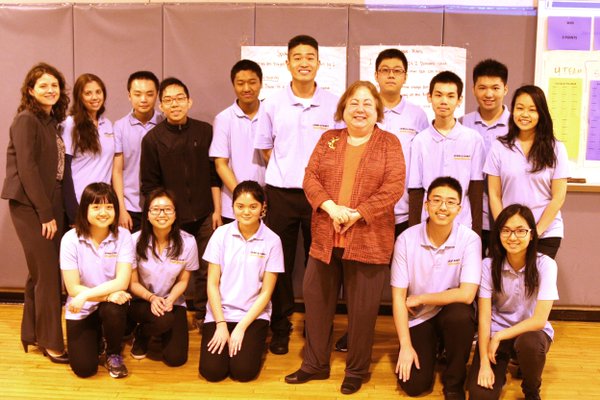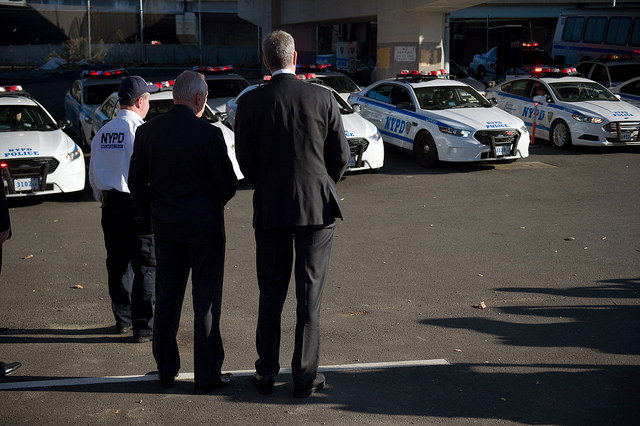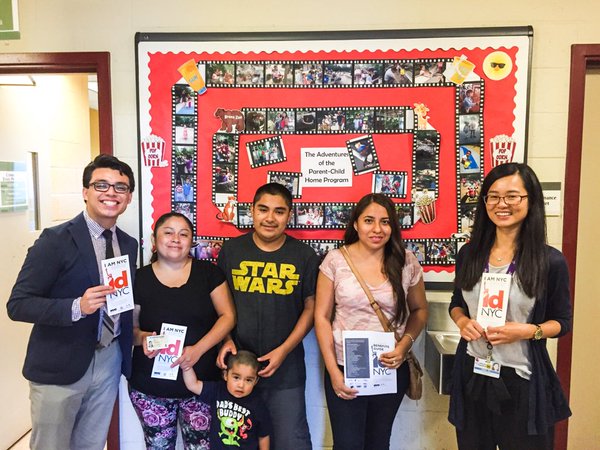Time for New York to Cut the Coal

Sen. Krueger, the author, visiting a school (photo via @LizKrueger)
In October, Governor Cuomo stood alongside former Vice President Al Gore and reiterated his commitment to reducing New York's carbon emissions 40 percent by 2030, as well as his willingness to phase out New York's coal-fired power plants. These were laudable statements in a high-profile public forum. Unfortunately, these goals will remain out of reach as long as the state continues to send the wrong market signals by requiring New Yorkers to underwrite dirty and uneconomical coal plants through increased electricity bills.
With just weeks left before global climate negotiations begin in Paris, now is the time for the Governor to make an enforceable commitment to phasing out coal-fired power by the end of the decade and ensuring a just transition for workers and communities dependent on coal.
New York's four remaining coal-fired power plants – Cayuga, Dunkirk, Huntley and Somerset – contribute 13 percent of New York's electricity sector carbon pollution. They no longer make a profit, yet the state has been keeping them operational at a cost of hundreds of millions of dollars.
The Dunkirk plant has received $90 million to continue operating through the end of 2015, and the Cuomo administration approved up to another $200 million over the next ten years; the Cayuga plant is receiving $155 million to continue operating through 2017, and has recently asked for an additional $145 million. These costs are paid for by local electricity customers, with plant owners pocketing the profits. Yet according to the utilities National Grid and NYSEG, transmission upgrades, many of which will be needed regardless of whether the coal plants remain operational, could address reliability issues at significantly lower cost when the plants close.
Taking these plants off-line will get us one third of the way to the state's carbon reduction goal while safeguarding the thousands of New Yorkers threatened by dangerous coal-fired pollution. But the state is currently sending market signals that directly contradict the Governor's emission reduction and renewable energy goals.
Coal plant owners are coming to expect that they can rely on New York's energy customers to keep their outdated and unnecessary plants on life support, a fact made clear by the recent request from Beowulf Energy to purchase Cayuga and Somerset. Time after time our government has required New Yorkers to foot the bill for dirty energy rather than investing in transmission upgrades that could get ahead of the curve on local reliability issues at a fraction of the cost.
New Yorkers are ready to pitch in to help transition away from coal. There is strong public and political support for a responsible transition plan for coal reliant communities - one that would require only a small portion of the money currently being spent. Earlier this year I joined over one-third of New York's legislature in signing a letter, authored by Assembly Member Barbara Lifton, urging Governor Cuomo to end coal subsidies and create a thoughtful statewide transition plan. Next, we will rally with elected and other allies, including the Sierra Club, as we continue to push for a smart, responsible path forward.
We are nearing a tipping point when it comes to the damage we're doing to our climate. As we approach the United Nations Conference on Climate Change in Paris, New York is poised to be an international leader in the fight against climate disruption. If we stop clinging to policies that keep our energy sector stuck in the past, the Empire State has the potential to lead the world in the bold transition to a clean energy economy. Governor Cuomo could lead us there by speeding up his commitment to phase out coal-fired power and taking a key step toward ensuring carbon pollution becomes a thing of the past.
***
Liz Krueger is a State Senator representing Manhattan. She is on Twitter @LizKrueger.
***
Have an op-ed idea or submission for Gotham Gazette? E-mail editor Ben Max: This email address is being protected from spambots. You need JavaScript enabled to view it.
A City We All Want to Live In

Mayor, PC (photo: Ed Reed/Mayor's Office)
In 1992, the Manhattan Institute's quarterly policy magazine, City Journal, published a special issue focused on "The Quality of Urban Life." At the time, New York was a dangerous, dirty, and purportedly ungovernable city. "Cities should be comfortable places," wrote the magazine's then-editor Roger Starr before setting out an ambitious agenda to reclaim New York's public spaces. In the years to come, New York followed through, cleaning up the streets and subways, reducing crime dramatically, and prospering.
Victories are never permanent, though, and serious challenges remain. Education tops the list. Strong schools are crucial for cities looking to attract and retain families. Yet New York's schools still suffer from many of the same problems that plagued them in 1992: union contracts that favor teacher seniority over performance; a lack of choice and alternatives for parents; and lax standards and curricula in the classroom.
We can point to signs of progress. With the encouragement of the Giuliani and Bloomberg administrations, charter schools have proliferated. The first city charter opened in 1999; more than 200 now operate in the city, and they've put up strong results. Black and Hispanic charter students outscore their counterparts in traditional district schools in both math and English language arts. Yet charters remain a too-small portion of the more than 1,800 schools that make up the public school system.
The teachers' unions remain powerful, but they face significant legal challenges. A case currently before the Supreme Court could put an end to the mandatory dues collection that makes public-employee unions so politically formidable in New York and elsewhere around the country. Common Core, though controversial, is establishing a more rigorous set of academic standards.
These are positive developments for the city's schoolchildren and their families, but New Yorkers deserve more from their education system—namely, greater levels of choice, competition, and access to information. With this goal in mind, the Manhattan Institute helped to launch SchoolGrades.org, which provides a transparent assessment of public school performance across the country. More such resources, combined with an embrace of flexibility in education by Albany and City Hall, could go a long way.
The remarkable improvement in New York City's quality of life since the 1990s has attracted new residents, an encouraging development but one that has multiplied demands on the city's aging infrastructure, including its public transportation system. Subway ridership hit a 65-year high in 2014 and is up over 60 percent from 1992 levels.
Major train lines—such as the 4, 5, and 6— regularly run at more than 103 percent capacity during peak ridership periods, as anyone who has crammed into a packed train during rush hour can attest. And the stations themselves are increasingly dismal, blighted by pooled water, litter, and crumbling walls.
Successful cities must plan for the consequences of success. This means building and maintaining the infrastructure to support new residents. A subway system unprepared to transport those people could quickly run into crisis.
Our political leaders must do better. Governor Andrew Cuomo once again stalled the few new stations on the long-planned Second Avenue subway. While three stops are slated to open next year on the Upper East Side, we're decades away from completing this vital project.
Concern over public order has also crept back into headlines. We're still a long way from the chaos of the 1980s and early nineties, but there's reason for concern. The rising numbers of vagrants, the more aggressive panhandlers making their way into Times Square, the growing push for decriminalizing "minor" offenses such as public urination and fare-jumping—these and other trends suggest a city on the verge of forgetting just how much effort it took to revive itself two decades ago.
We must avoid what longtime Manhattan Institute senior fellow Fred Siegel described in 1992 as a "collapse of common standards" in our city. When ordinary citizens retreat from public spaces, it leaves a vacuum to be filled by the forces of disorder. We know where that leads: to a city that repels people and businesses.
Whatever problems persist in New York City, we must remember how far we've come. The reformers of 1992 sought to rescue a city on the brink. This week, during the Manhattan Institute's quality-of-life week, we call on all New Yorkers to help preserve the city's gains for future generations.
***
Lawrence Mone is President of the Manhattan Institute. Read City Journal here and follow the Manhattan Institute on Twitter @ManhattanInst.
***
Have an op-ed idea or submission for Gotham Gazette? E-mail editor Ben Max: This email address is being protected from spambots. You need JavaScript enabled to view it.
IDNYC Cardholders Await Assurance Ahead of Year Two

photo via @IDNYC
In September 2014, Mayor de Blasio held a major press eventaround the city’s IDNYC program that centered entirely on one benefit of the new municipal identification card: the free one-year membership offer at 33 museums and cultural institutions part of the Cultural Institutions Group (CIG). In the accompanying written announcement, 16 city and community leaders were quoted praising the program, especially this cultural enrichment aspect. One said it “has the potential to transform lives.”
And indeed it surely has, as many New Yorkers have jumped at the perk - over 30,000 IDNYC cultural memberships were accessed as of the end of July, according to the city. The transformative potential of the ID is not entirely nested in a cardholder’s newfound ability to visit the Basquiat exhibit at the Brooklyn Museum over the summer, of course. Identification is a fundamental societal resource. In fact, the city announced at the end of July that over 400,000 IDNYC cards had been granted. It is this number, and the real target populations of the program - undocumented immigrants, people lacking stable housing, and others - that are indicative of the importance of the program. But the larger-than-expected enrollment and the vulnerable populations involved are indicative of how important it is that the city clearly indicate what year two of the program will look like.
Thus far, there has been little information from the mayor or his Office of Immigrant Affairs (MOIA), which has led the IDNYC program. As Thanksgiving approaches, it is time that cardholders are informed about its future. While MOIA representatives have said that the program will continue to grow and no one should feel at risk of losing the card’s basic benefits, cardholders would surely feel more at ease hearing details from their mayor.
New Yorkers realize how important identification is, though many who have had a driver’s license since being a teenager may need a reminder. ID is required to perform a number of seemingly innocuous tasks: enter certain spaces (e.g. municipal buildings and schools, to access city services), apply for an apartment lease, open a bank account, get a public library card, sit for the high school equivalency exam, and, during encounters with the NYPD, receive a summons or desk appearance ticket in lieu of transport to a police station.
Basic identification is a less flashy, but essential benefit of the municipal ID; the ID gives a wide variety of city residents (in particular, undocumented immigrants, homeless individuals, transgender individuals, and victims of domestic violence in non-stable housing situations) a means to perform a number of life-stabilizing tasks. In addition to providing a vehicle to access services and material resources, the ID itself is proof of societal membership.
This notion of “membership” is especially important for actualizing some of the less visible benefits of the municipal ID program. The card provides formal recognition, which can command respect from others, particularly during encounters with the police, and instill a sense of self-respect among cardholders who enjoy fresh opportunities to take advantage of resources and services. Respect is not just “the golden rule;” in the eyes of established social justice theorists, “respect” is actually an essential dimension of well-being.
The municipal ID provides each cardholder with a sense of everyday belonging in society and entitlement to access available resources and support. These phenomena (“belonging” and “perceived availability of support”) are two mechanisms by which physical and psychological well-being can be improved, according to social science research. Furthermore, the public health tradition of inquiry, endorsed by the Institute of Medicine/National Academy of Sciences and the World Health Organization, known as the “social determinants of health” suggests that the perception of greater resource availability is likely to increase utilization of accessible support and positively impact health. How? With more resources (such as money, knowledge, and social connections) people are better able to buffer against adverse health events and prevent health shocks from being catastrophic if/when they do happen to occur.
With such potential and obvious resonance with de Blasio’s OneNYC vision for a “strong and just” city, the future of the IDNYC program and the longevity of its benefits should not be murky this late in the year.
Contacted about the program and its future, Mayor’s Office of Immigrant Affairs Commissioner Nisha Agarwal said in a statement, “From its launch, Mayor Bill de Blasio and his administration have said that the IDNYC program and its utility will grow over time. IDNYC will continue to progress and serve even more New Yorkers in Year Two. We look forward to sharing more detailed news before the start of the second year of the program.”
The card and benefits are free, between January 1, 2015 and December 31, 2015, for anyone that can meet the proof of identity and city residency requirements (which make allowances for non-stable housing situations). But, puzzlingly, there has been little public discussion about what happens come January 1, 2016. Will the card and its benefits remain free? Will the hallmark CIG promotions lapse? The elimination of the CIG benefit could have potentially deleterious effects, given that it was a strategic move to make the card universally appealing (and reduce potential for associated stigma). Most importantly, will the municipal ID continue to be, or even expand its usefulness as, formally recognized identification? Or will it become less useful over time? There are already several restrictions on the utility of the card (it can only be used at certain banks to open accounts, it does not serve as proof of identity for a driver’s license, does not authorize receipt of public assistance benefits, and cannot be used as identification during plane travel).
Certainly, there are life-changing benefits associated with this municipal ID program, and as the largest in the country (with those 400,000 cardholders as of July), this program is in urgent need of a long-term plan that ensures: the municipal ID continues to be regarded as formal and useful identification, cardholders maintain essential benefits, and the card remains universally appealing – such that cardholders are not required to inadvertently accept a potentially isolating and stigmatizing “other” status.
Like many New Yorkers, I eagerly await information about year two of IDNYC.
***
Lauren A. Haynes is an MPH candidate studying health policy and social determinants of health at Columbia University, Mailman School of Public Health. She has also worked for New York City’s public hospital system.




